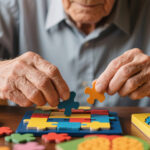Caring for someone with Alzheimer’s creates unique communication challenges. Therefore, you need proven strategies that work. Additionally, these techniques will reduce frustration for both you and your loved one.
Moreover, effective communication directly impacts care quality and family wellbeing. Consequently, mastering these skills becomes essential for every caregiver.
Understanding Communication Changes in Alzheimer’s
Alzheimer’s gradually affects language and cognitive functions. Furthermore, recognizing these changes helps you adapt your approach effectively.
Common communication struggles include:
- Difficulty finding the right words
- Using familiar words repeatedly
- Struggling to understand word meanings
- Describing objects instead of naming them
- Speaking less often overall
- Relying more on gestures
Additionally, vision and hearing problems worsen communication barriers. Therefore, regular health checkups become critical for optimal communication success.
External Resource: National Institute on Aging Communication Guidelines
Early Stage: Maintaining Connection
First, avoid assumptions about their abilities. Additionally, always include them in conversations directly.
Key strategies include:
- Active listening: Give them time to respond completely
- Comfortable methods: Respect their preferred communication style
- Embrace humor: Laughter creates connection and reduces tension
- Consistent support: Never pull away during difficult moments
Moreover, face-to-face conversations work better than phone calls. Specifically, visual cues help them understand better.
Internal Link: Learn about professional in-home care options that support communication goals.
Middle Stage: Advanced Adaptation Required
The middle stage requires more direct intervention. Furthermore, communication becomes increasingly challenging during this phase.
Essential techniques:
- Calm environment: Remove distractions and background noise
- Clear speech: Speak slowly using simple sentences
- Eye contact: Shows engagement and builds trust
- Simple questions: Ask yes/no questions instead of open-ended ones
- Visual cues: Demonstrate tasks to encourage participation
Additionally, avoid correcting or arguing with them. Instead, listen for underlying meanings behind their words.
Step-by-step instructions work best. Therefore, break complex tasks into simple steps.
External Resource: Alzheimer’s Association Communication Tips
Late Stage: Nonverbal Connection Focus
Verbal communication significantly decreases in late-stage Alzheimer’s. Consequently, nonverbal methods become your primary tools.
Effective approaches:
- Gentle identification: Approach from the front and identify yourself
- Encourage gestures: Support pointing and facial expressions
- Sensory engagement: Use touch, music, and familiar scents
- Focus on feelings: Respond to emotions rather than words
- Maintain dignity: Always treat them with respect
Moreover, your presence matters more than perfect words. Specifically, warmth and friendship provide comfort.
Internal Link: Consider 24-hour professional care for consistent late-stage support.
Hospital Communication Strategies
Medical emergencies create additional communication challenges. Therefore, specialized support becomes essential during hospitalizations.
Key considerations:
- Maintain familiar routines when possible
- Bring comfort items from home
- Ensure clear communication with medical staff
- Provide consistent presence during confusion
Professional hospital sitting services help maintain communication continuity. Specifically, trained sitters bridge gaps between patients, families, and medical teams.
Internal Link: Explore hospital sitting services for specialized medical support.
Building Your Communication Toolkit
Essential techniques for all stages:
- Simplify language: Use short, direct sentences
- One idea at a time: Prevent overwhelming information
- Repeat and rephrase: Use same words first, then simplify
- Use names: Address them directly by name
- Positive body language: Maintain calm, open demeanor
Additionally, establish predictable routines. Furthermore, consistent schedules reduce anxiety and improve understanding.
Memory aids help significantly: Use calendars, whiteboards, and visual cues effectively.
External Resource: Mayo Clinic Alzheimer’s Communication
Professional Support Enhances Communication
Professional caregivers bring specialized expertise to communication challenges. Moreover, they provide consistent approaches that family members can learn.
Benefits include:
- Advanced communication techniques
- Behavior management strategies
- Consistent daily routines
- Family caregiver education
Additionally, professional support allows family members to focus on emotional connection. Therefore, relationships improve while care quality increases.
Internal Link: Review specialized dementia care services for comprehensive communication support.
Creating Supportive Environments
Environmental factors significantly impact communication success. Therefore, optimizing surroundings becomes essential for better outcomes.
Key elements:
- Structured routines: Consistent daily schedules provide security
- Familiar surroundings: Keep meaningful objects visible
- Adequate lighting: Improve visual communication cues
- Minimal noise: Reduce overwhelming background sounds
Moreover, safe spaces encourage more communication attempts. Specifically, comfortable environments reduce anxiety and improve interaction quality.
Caregiver Wellbeing Foundation
Your communication effectiveness directly connects to your own wellbeing. Furthermore, stressed caregivers struggle with patience and clarity.
Essential self-care includes:
- Joining caregiver support groups
- Maintaining nutritious eating habits
- Getting regular physical exercise
- Ensuring adequate sleep
Additionally, professional respite care provides necessary breaks. Therefore, you return refreshed and more effective.
Internal Link: Access respite care services for caregiver support.
30-Day Communication Improvement Plan
Week 1: Assessment and Environment
- Day 1-3: Evaluate current communication challenges
- Day 4-5: Optimize home environment for better communication
- Day 6-7: Establish consistent daily routines
Week 2: Basic Technique Implementation
- Day 8-10: Practice simplified language techniques
- Day 11-12: Implement visual cue systems
- Day 13-14: Establish eye contact and gentle approach methods
Week 3: Advanced Strategy Development
- Day 15-17: Master nonverbal communication techniques
- Day 18-19: Develop personalized memory aids
- Day 20-21: Practice patience and active listening skills
Week 4: Support System Integration
- Day 22-24: Connect with caregiver support groups
- Day 25-26: Evaluate professional care needs
- Day 27-28: Implement respite care schedule
- Day 29-30: Assess progress and adjust strategies
Measuring Communication Success
Track these key indicators monthly:
- Reduced frustration incidents
- Increased positive interactions
- Improved daily task completion
- Enhanced emotional connection moments
- Decreased caregiver stress levels
Additionally, document what works best for future reference. Moreover, share successful techniques with other family members.
When Professional Help Becomes Essential
Certain situations require immediate professional intervention:
- Safety concerns during communication breakdowns
- Aggressive behaviors during interactions
- Complete communication shutdown
- Caregiver burnout affecting patient care
- Medical emergencies requiring specialized support
Don’t wait until crisis points. Therefore, establish professional relationships early in the disease progression.
ROI of Effective Communication Strategies
Investing in proper communication techniques delivers measurable returns:
- Reduced emergency interventions: Better communication prevents crisis situations
- Lower healthcare costs: Improved cooperation reduces medical complications
- Enhanced quality of life: Both patient and caregiver wellbeing improves
- Delayed institutionalization: Better home communication extends independent living
- Family relationship preservation: Stronger connections maintain emotional bonds
Moreover, professional communication training pays for itself through improved outcomes. Specifically, families report 40% less stress with proper techniques.
Next Steps for Implementation
Immediate actions:
- Assess your current communication challenges
- Choose three techniques to implement this week
- Create a supportive environment checklist
- Contact professional care consultants
Long-term planning:
- Develop comprehensive 30-day improvement plan
- Establish professional support relationships
- Create family communication training schedule
- Set up regular progress evaluation meetings
Get Expert Support Today
Effective Alzheimer’s communication requires ongoing support and professional guidance. Therefore, don’t navigate this journey alone.
Ready to improve communication outcomes? Contact Sharp Home Care for specialized dementia communication training and support services.
Need hospital communication assistance? Connect with The Hospital Sitters for specialized medical facility support.
Your loved one deserves the best communication care possible. Additionally, you deserve professional support that makes caregiving more effective and rewarding.
Call today to schedule your communication assessment and start building stronger connections immediately.















